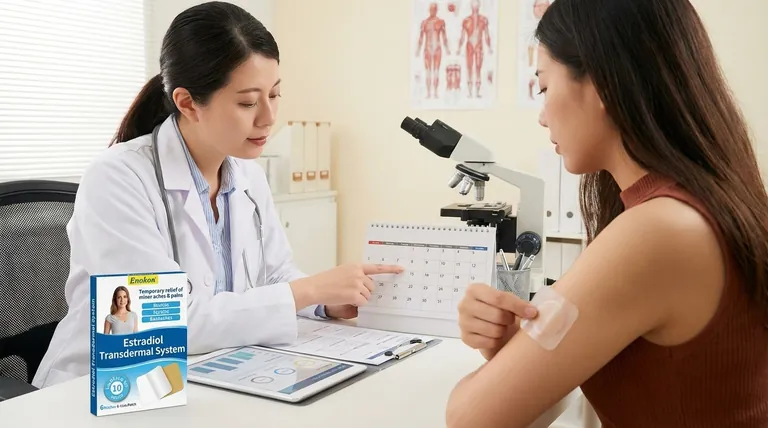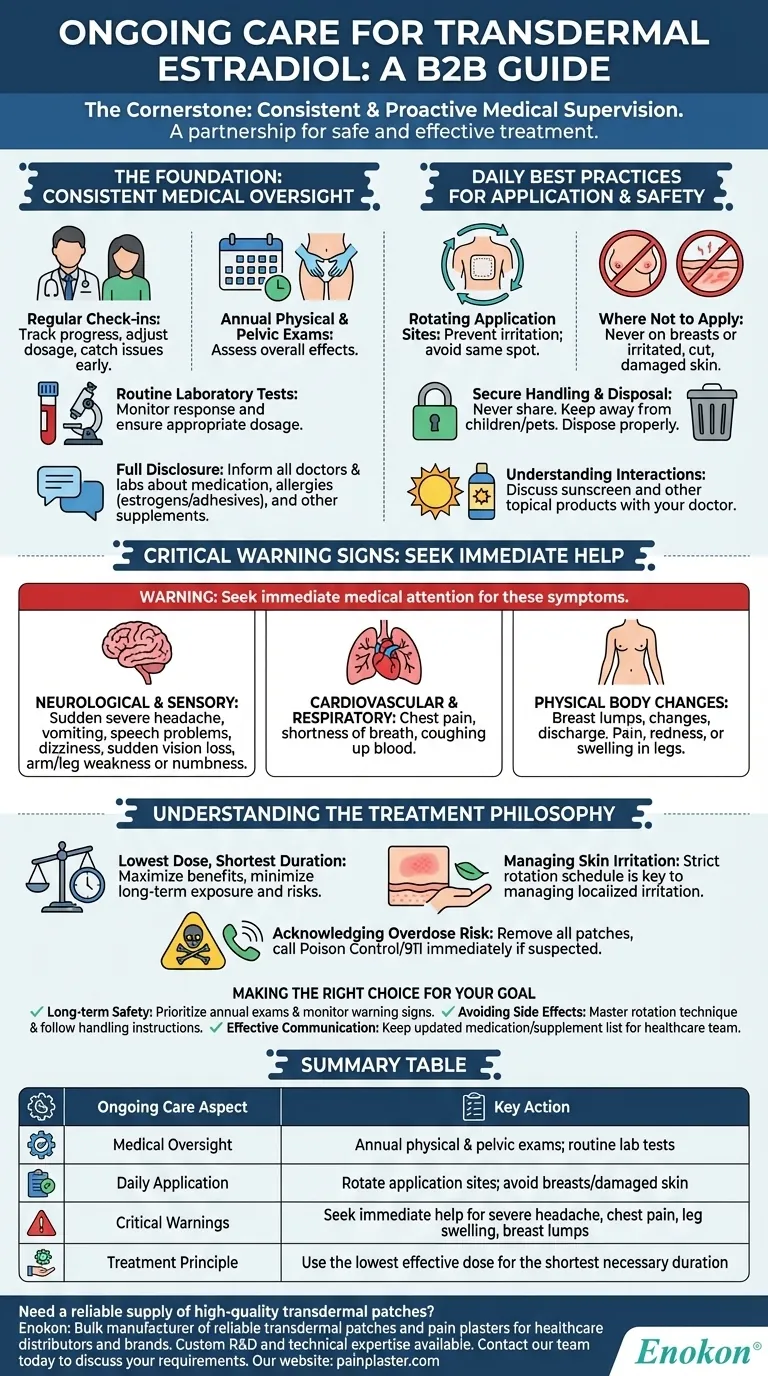The cornerstone of ongoing care for transdermal estradiol is consistent and proactive medical supervision. This involves regular physical exams, including pelvic exams, and specific lab tests to monitor your body's response and ensure the treatment remains both safe and effective.
Successful management of transdermal estradiol therapy is a partnership between you and your healthcare provider, combining your diligent daily practices with their essential medical oversight.

The Foundation: Consistent Medical Oversight
Your treatment plan is not static. Regular check-ins with your doctor are non-negotiable to track your progress, adjust dosage if necessary, and catch any potential issues early.
Annual Physical and Pelvic Exams
You should have a complete physical exam, including a pelvic exam, at least once a year. This allows your doctor to assess the overall effects of the treatment on your body.
Routine Laboratory Tests
Your doctor will likely order periodic lab tests. These tests are crucial for checking how your body is responding to the estradiol and ensuring your dosage is appropriate.
Full Disclosure with Your Team
Always inform all of your doctors and any laboratory personnel that you are using this medication. It's also vital to disclose any allergies, especially to estrogens or adhesives, as well as all other medications, supplements, and herbal products you take.
Daily Best Practices for Application and Safety
How you handle and apply the medication daily has a significant impact on its safety and effectiveness.
Rotating Application Sites
To prevent skin irritation, it is critical to rotate the location where you apply the patch. Consistently applying it to the same spot can lead to redness and discomfort.
Where Not to Apply
Never apply the patch to your breasts or to skin that is irritated, cut, or damaged in any way.
Secure Handling and Disposal
This medication should never be shared. Keep new and used patches away from children and pets. Used patches still contain active medication and must be disposed of properly according to instructions.
Understanding Potential Interactions
Factors like sunscreen may affect how the medication is absorbed through your skin. It's important to discuss your use of other topical products with your doctor.
Critical Warning Signs: When to Seek Immediate Help
Certain symptoms require immediate medical attention as they can indicate a serious adverse reaction.
Neurological and Sensory Symptoms
Contact your doctor or emergency services immediately if you experience a sudden severe headache, vomiting, problems with speech, dizziness, sudden vision loss, or weakness or numbness in an arm or leg.
Cardiovascular and Respiratory Signs
Seek immediate help for chest pain, shortness of breath, or if you begin coughing up blood. These can be signs of a serious cardiovascular event.
Physical Body Changes
Report any breast lumps, changes in your breasts, or nipple discharge to your doctor without delay. Additionally, any pain, redness, or swelling in your legs requires urgent medical evaluation.
Understanding the Treatment Philosophy
Effective hormone therapy is guided by principles designed to maximize benefits while minimizing risks.
The "Lowest Dose, Shortest Duration" Principle
The standard medical guidance is to use the lowest effective dose of estradiol for the shortest duration necessary to achieve your treatment goals. This minimizes long-term exposure and potential risks.
Managing Skin Irritation
The most common trade-off of a transdermal patch is the potential for localized skin irritation. Following a strict rotation schedule for application sites is the primary strategy to manage this.
Acknowledging Overdose Risk
In the rare event of an overdose, such as applying too many patches, you must remove all patches and contact a Poison Control center or call 911 immediately.
Making the Right Choice for Your Goal
Your approach to ongoing care should be proactive and informed by your specific priorities.
- If your primary focus is long-term safety: Prioritize scheduling your annual physical and pelvic exams, and be vigilant in monitoring for the critical warning signs.
- If your primary focus is avoiding daily side effects: Master the technique of rotating application sites and follow all instructions for proper handling and disposal.
- If your primary focus is effective communication: Keep an updated list of all medications and supplements to share with your healthcare team at every appointment.
Proactive monitoring and open communication with your doctor are the keys to using transdermal estradiol safely and effectively.
Summary Table:
| Ongoing Care Aspect | Key Action |
|---|---|
| Medical Oversight | Annual physical & pelvic exams; routine lab tests |
| Daily Application | Rotate application sites; avoid breasts/damaged skin |
| Critical Warnings | Seek immediate help for severe headache, chest pain, leg swelling, or breast lumps |
| Treatment Principle | Use the lowest effective dose for the shortest necessary duration |
Need a reliable supply of high-quality transdermal patches for your patients? As Enokon, a bulk manufacturer of reliable transdermal patches and pain plasters, we provide healthcare and pharmaceutical distributors and brands with consistent, high-quality products. Benefit from our technical expertise for custom R&D and development to meet your specific needs. Contact our team today to discuss your requirements.
Visual Guide

Related Products
- Far Infrared Heat Pain Relief Patches Transdermal Patches
- Heating Pain Relief Patches for Menstrual Cramps
- Far Infrared Pain Patch Relief Pain Reliever for Back
- Far Infrared Knee Pain Patch Heat Patches for Pain Relief
- Far Infrared Deep Heat Relief Patches Medicated Pain Relief Patches
People Also Ask
- How does capsaicin work in the medicated heat patch? The Science Behind Pain Relief
- Are heat patches safe for all body parts? Key Safety Zones and No-Go Areas Explained
- What did the UK Million Women Study find regarding transdermal versus oral hormone therapy? A Safer Choice for Gallbladder Health
- How does the Deep Heat Back Patch work? A Drug-Free Solution for Targeted Pain Relief
- What are the key features of the Deep Heat Pain Relief Back Patch? Get Up to 16 Hours of Drug-Free Relief















